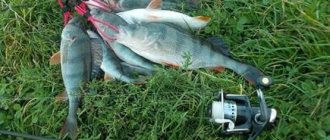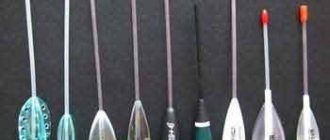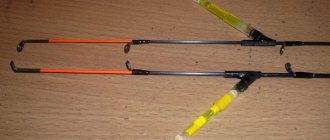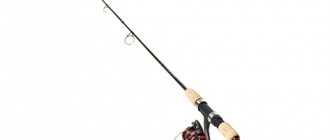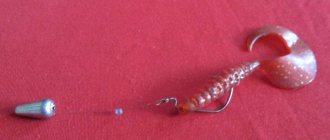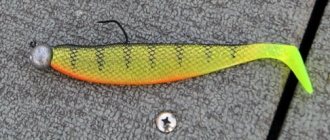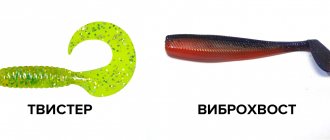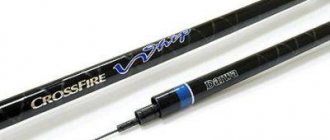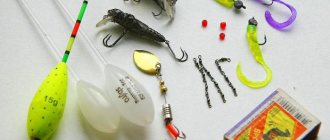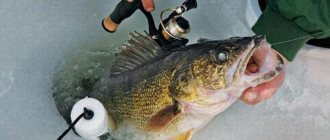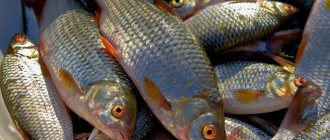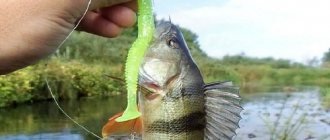Drop shot is one of the types of spaced rigs used when fishing with a spinning rod, in which the sinker is at the very end of the line, and the hook with bait is at some distance above it. Drop shot is a simple and effective fishing method that allows you to catch a wide variety of fish species. With a drop shot, you can fish hard-to-reach places in the reservoir, as well as catch fish that are in a passive state. The drop shot allows you to use a variety of spinning rods, including allowing you to stay at one point for a long time. Spinners who added this fishing method to their arsenal appreciated its effectiveness.
In our publication, we will talk about the history of the appearance of the drop shot, its advantages and disadvantages, we will talk about the correct installation of this equipment, we will talk about what kind of fish and when you can catch with a drop shot, we will discuss the wiring that can be used when fishing.
History of the drop shot
American and Japanese fishermen argue among themselves who was the first to come up with the drop shot as a new method of fishing. Japanese anglers believe that the drop shot was invented by their compatriot, Japanese angler Hariki Nuromaki. According to the Japanese side, Americans first became acquainted with the drop shot when the Japanese sports fisherman Seyo Kato successfully used the drop shot at black bass fishing competitions in the United States.
According to the American side, the drop shot was invented in the USA in the state of Texas, in the same place where the “Texas equipment” is well known to anglers. Americans believe that more than 50 years ago, American anglers caught fish with a rig they called “big bass.” It was this equipment that was the prototype of the future drop shot. In their opinion, Japanese fishermen have only made some improvements to suit local fishing conditions.
Benefits of a drop shot
The drop shot is a highly effective method of spinning fishing that complements other types of spaced equipment and allows you to achieve high fishing results in different types of reservoirs.
Drop shot has a number of advantages over other fishing methods:
- The drop shot allows you to fish in hard-to-reach, snagged places where there is a high probability of getting caught.
- A drop shot allows you to play the bait in one place by jerking the tip of the spinning rod, thereby provoking the predator to attack.
- The drop shot is designed to catch a passive predator and is capable of provoking an attack from even the most apathetic and lethargic fish, which does not want to feed and does not react to bait floating by, presented in other ways. When catching a passive predator, a drop shot often shows results no worse than a retractable leash.
- Drop shot can be used with a wide variety of silicone baits, but shows the best results when using passive silicone baits: slugs and worms.
- Simple installation right at the fishing spot, simple, easy-to-learn wiring, and low cost of equipment elements allow beginner spinners who do not have much fishing experience to fish with a drop shot.
Installation, elements of drop shot equipment.
photo netzwerk-angeln.de
Installation
To begin with, you need to cut a piece of fishing line from 50cm to one meter long. Then you need to thread the fluorocarbon into the eye of the hook and tie it to the fishing line so that the hook itself is perpendicular to the fishing line. Example in the photo below:
Drop shot knot, photo netzwerk-angeln.de
Next, you need to determine which end of the fishing line needs to be tied to the load, and which to tie to the cord. The basic rule: the tip of the hook should be directed upward. According to the position of the hook, further connections need to be made. Such equipment can be prepared in advance at home by winding them on a reel, so as not to waste precious time while fishing.
Hooks
Types of drop shot hooks: squiggle hook (1) , swivel hook (2), offset hook (3) , long shank hook (4) .
The hook must be selected based on the object being fished, the fishing location and the type of silicone bait used. There are special drop-shot hooks with built-in swivels (2) or special shapes with “squiggles” (1). But their use is limited due to the fairly high price and is intended for amateurs. In addition, such hooks cannot be found everywhere. The justification for such hooks may arise if they are attached to a metal leash, if the object of fishing is a pike, or a toothy predator is often caught in the bycatch. Typically, either offset hooks (3) or single hooks with a long (4) or standard shank are used. The latter are used when the bait is attached to the head part or is used, the so-called wacky installation, using silicone worms.
Offset hooks are mainly necessary for fishing in snags and cluttered areas or when using larger baits.
Fluorocarbon line.
The use of fluorocarbon fishing line is explained not so much by its invisibility to fish, but by its rigidity. Directly, attaching a hook to a cord is unjustified: a soft cord easily sags and can not only tangle the tackle, but also will not allow for high-quality animation of the bait. Yes, and it’s also not worth reducing the diameter of fluorocarbon, given that the breaking load of the latter is significantly inferior to a braided cord. It is optimal if the breaking strength of both the cord and the fishing line is comparable. Do not forget that a pike may covet the bait and a “thick” fly will save not only the equipment, but also the trophy itself.
Sinker.
Types of weights for a drop shot: stick weight (1), pear-shaped weight (2) .
Drop shot weights can come in different shapes, but there are special weights in the form of a stick (1) or pear-shaped (3). Such sinkers have increased cross-country ability and allow you to fish in “strong” places. A slight drawback of these sinkers is that, having an elongated shape, when there is a pause in the retrieve, they fall flat to the bottom and can give false bite signals. And such sinkers usually cost more than others. In fact, for a drop shot, the choice of weight shapes is not so important: any weight can do. Moreover, if while fishing it suddenly turns out that there are no special ones, you can get by with an ordinary Cheburashka. The weight of the load is more important. Here, too, you should not engage in excessive miniaturization.
The sinker must be selected taking into account the test of the rod, and the optimal option will be in which the spinning rod will be loaded and cast as far as possible. Here you need to take into account that the windage of all the equipment is quite high, and sometimes there is a need to throw it to the right place. It is also necessary to take into account other factors, such as wind, depth, presence or absence of current, etc. Unless the current is strong enough, it can be reduced if fishing is carried out by drift. But the main argument in choosing a sufficient sinker weight is the fishing method itself. After all, when doing a drop shot, you often have to animate with a slight twitch of the tip of the spinning rod, in which the sinker practically remains in place or slowly drags along the bottom. It is clear that with the light weight of the cargo it will be difficult to implement such a technique.
Lures.
The main type of silicone bait when fishing with a drop shot is the so-called “slug”. This bait has a worm-shaped or forked tail, like the tail of a fish. Therefore, slugs are passive baits. This silicone has low windage, has less weight than a vibrotail of similar shape and size, and very much resembles a fry. This bait is especially good when fishing for pike perch. But the arsenal of modern silicone baits is unusually wide, and with this installation, you can use almost all of them. Well, perhaps, except for special sea, surface or giant jerking baits. True, the size of silicone still needs to be limited. The fact is that the bait will not play well if it weighs down a tightly tied hook with its weight. For walleye, the optimal size is 3-4 inches long. For perch 2-3 inches. Of course, this is not an axiom.
In addition to the mentioned slugs, twisters, worm-like baits and various crustaceans and insect-like creatures are good options. The latter are good for catching perch. But there are often cases when even non-predatory fish bite on this type of bait.
But don't limit yourself to silicone only. Various artificial baits, such as various flies and streamers, are quite suitable. The use of foam rubber fish is also quite justified.
Ideally, the bait will have its own scent. This will not only increase the chances of a bite, but may provoke the predator to attack again if there was a miss the first time. At the same time, the sensation of biting with a doublet or triplet is guaranteed to be unforgettable. You can also use an attractant.
Disadvantages of the drop shot
Despite its high efficiency and a large number of advantages, the drop shot also has its disadvantages:
- The drop shot is a vertical rig that is highly effective when fishing in deep places, from a boat or on a high bank. When fishing from a low bank, at shallow depths, it turns out to be ineffective due to the small angle between the main line and the bottom.
- A drop shot is ineffective when you need to fish a large area of water in search of an active feeding predator
- The drop shot is not very effective when fishing in strong currents. The drop shot must occupy a vertical position in the water, but when fishing in the current, this is almost impossible to do.
You may be interested in: Fishing in Altai: 20 best places for fishing
What is better, a drop shot or a retractable leash?
Anglers often compare a drop shot and a retractable leash. Both fishing methods are variants of spaced equipment, but each option has its own advantages and disadvantages.
The drop shot has greater sensitivity compared to the retractable leash, due to the installation features. When fishing with a retractable leash, the angler cannot always feel the bite.
A drop shot is better suited for fishing in difficult local areas of a reservoir, near holes, in snags, in areas with a lot of underwater vegetation, as it allows you to play the bait vertically, literally in one place.
The retractable leash allows you to make long casts, from 20 to 70 meters, and fish a large area of the reservoir. For fishing with a diversion leash, areas of reservoirs with complex bottom topography, with coastal and channel edges, but without snags and areas heavily overgrown with underwater vegetation, are well suited.
You can read more about what a diverter leash is, how to mount it correctly, its advantages and disadvantages, what kind of fish you can catch with it and the types of lines used when fishing with it in our article diverter leash: installation, fishing, diagrams, photos , video
Differences in fishing with a drop shot and a retractable leash
For a retractable leash, both sinking and floating silicone baits can be used. At the same time, for their active animation it is necessary to tap the weight, that is, the entire equipment on the bottom. Otherwise, a twister or any other active bait may simply not start if, for example, you try to carefully animate it without moving the weight from its place. Micromovements of the bait will also occur when the load is at rest, but its tail part will no longer work effectively.
The distinctive feature of the drop shot is its spot fishing. This equipment becomes highly effective when a passive fish is standing on some local spot and can only be stirred up by animating the bait literally in one place (jerking with the tip of the spinning rod and pulling the cord without lifting the sinker from the bottom). But if you need to throw a silicone bait into a clearing in a densely overgrown area with grass, under a snag, branches overhanging the water, and stop at the exit from the hole, the bottom of a dump or a “navel,” then the best bottom equipment will again be a drop shot (especially if the above requirements refer to a body of water with a current).
Methodical animation with edible rubber in one place with long pauses can be replaced by active powerful jerks of the spinning rod with active tapping of the sinker on the bottom. The determining factor in the choice of wiring will be, as in the case of other spinning baits, the degree of passivity of the fish.
What kind of fish can you catch with a drop shot?
With a drop shot you can catch any predatory fish that is caught with a spinning rod: pike perch, perch, pike, asp, chub, bersh, trout, grayling. Of all the predatory fish, perch is the most commonly caught using the drop shot, followed by pike perch. In addition to predatory fish, some anglers successfully catch peaceful fish such as crucian carp, bream, rudd, roach, carp, and ide using a drop shot. To catch peaceful fish, small hooks are used and miniature baits are placed on them.
When and where can you fish with a drop shot?
Drop-shot fishing is carried out throughout the open water season, from the formation of the first polynyas until the establishment of stable ice cover. Some anglers successfully fish with drop-shots on ice-free reservoirs all winter.
The best places for drop-shot fishing on rivers and bodies of water with standing water are:
- Snags. Drop-shot fishing can be carried out both in impassable rubble, sparse supports, and next to single flooded tree trunks or branches.
- Rocky areas. The drop shot is effective both when fishing large stones and areas strewn with small stones and pebbles.
- Areas heavily overgrown with underwater vegetation. The use of rigs in such places, in which the bait is located below the load, leads to a large number of hooks.
- Heavily silted places. The turbidity raised by the drop shot sinker from the bottom attracts the attention of nearby fish.
- Near bottom anomalies that serve as shelter for predatory fish. Coastal and channel edges, deep slopes, hummocks, hills, grooves, hollows and pits are all good places for drop-shot fishing.
Main components of equipment
The drop shot rig does not include any special elements. Everything you need: hooks, line and sinkers can be purchased at a regular fishing store. Drop-shot equipment elements
Hooks
For drop-shot fishing, you can use both regular single hooks and offset ones. Regular single hooks are used in clean areas, offset hooks are used in areas where there is a high risk of snagging. There are special hooks for drop shot, they are secured in such a way that the hook is perpendicular to the fishing line, with the tip facing up. The size of the drop shot hook is selected depending on the size of the bait and the size of the intended prey.
Sinkers
For a drop shot, sinkers of different shapes can be used, depending on the fishing conditions. The most common form of drop shot sinker is the elongated stick-shaped sinker. A sinker of this shape best overcomes underwater obstacles: snags and stones. In fishing areas where there are no obstacles, you can use eared sinkers, ball-shaped sinkers or teardrop-shaped sinkers. Sinkers should be attached to the line using a swivel to avoid twisting the line.
You may be interested in: Perch
The weight of the sinker for a drop shot is selected depending on the fishing conditions. The weight of the sinker should not be too light so that the sinker can control the bait, and at the same time, the weight of the sinker should not be too heavy so that the fish does not feel its weight at the time of the bite. The selection of the weight of the sinker is based on the rule: the greater the depth and the stronger the current, the greater the mass of the sinker should be.
Most often, for a drop shot, sinkers weighing from 3 to 14 grams are used; when fishing in a strong current, the weight of the sinker increases to 20 grams or more. When selecting the weight of the sinker, the angler must take into account the fact that when fishing, he must feel the moment the weight falls and touches the bottom; only in this case will he be able to perform high-quality fishing and animation of the bait.
Recently, drop-shot fishing using silicone baits 2.5 cm long or less and using very light weights has become widespread among our fishermen. This method of fishing began to be called micro drop-shot and nano drop-shot. This method is used to catch not only predatory fish, but also peaceful fish, such as crucian carp, roach, and ide.
Line, fluorocarbon
When fishing with a drop shot, the main line can be of any type, both braided and monofilament. It is desirable that the main line is not too thick and has a low degree of elongation. The breaking load of the main line should be greater than that of the line on which the drop shot is mounted.
To mount a drop shot, fluorocarbon or monofilament line is used. Fluorocarbon is preferred because it has less elongation and is less noticeable in the water. For catching small fish, you should use fluorocarbon line with a diameter of 0.2-0.25 mm, for catching medium and large fish, 0.30-0.35 mm.
Many anglers use regular monofilament with a diameter of 0.14-0.25 mm to mount a drop shot. The main fishing line and the fishing line on which the drop shot is mounted are connected to each other using special fishing knots (Albright, carrot), using the loop-to-loop method or using a swivel.
Methods of fishing and posting
Drop-shot and wiring: 1. rigging;
2. playing with bait without lifting the load; 3. step or toss. A special feature of the dropshot rig is that the bait moves freely and is not held by a sinker at the bottom. This means that the angler can use completely different techniques for “playing” the bait.
Wiring methods:
- uniform - using a reel, the fisherman pulls the bait along the bottom of the reservoir, as a result the turbidity rises and this attracts fish;
- standard or jig - the fisherman reels in the line using a reel, the load rises sharply, at the same time you need to smoothly swing the spinning rods to the right and left;
- bottom “game” - the line rises and falls with a certain periodicity, the drop shot is abruptly transferred from one place to another.
Drop shot for perch, pike perch
The gear for fishing for pike perch and pike perch is largely identical, there are only minor differences in the thickness of the fishing line, as well as the dimensions of the bait. Many experts claim that drop shot perch fishing is the most effective; in their reviews, fishermen write that with such equipment you can catch as many fish as you want.
So, for catching predatory fish, it is recommended to use an ultralight spinning rod with a test weight in the range of 0.5-6 g. Microweight (simple split pellets used in float fishing) can be attached in two ways:
- clamp the swivel in the cut;
- attaching it to a fishing line is a comfortable method, since all actions can be performed faster.
Drop shot can easily cope with any perch, so in this case it is important to choose the right size of bait; artificial bloodworms have proven themselves to be excellent. The larger the bait used, the larger the fish you can catch with the drop shop.
As for pike perch, you will need more powerful and durable equipment, but otherwise all actions are identical.
Advice! When fishing for pike perch, the bait is slightly twitched above the bottom, but when fishing for perch, the bait is used to move it smoothly.
Dropshot for pike
It is recommended to use drop shot rigs for pike on metal leashes. Here is one of the most common installation methods:
- unwind one twist of the leash-string;
- a hook and bait are attached to the untwisted part;
- another leash is attached to the finished leash (considered the main one) through twisting; its function is to remove the load;
- A sinker is attached to the free edge of the second leash, a twist is used, and a special fastener is used.
Advice! Instead of a second leash, fluorocarbon fishing line, diameter 0.4 mm, is used.
Winter ice dropshot
Winter fishing with a drop shot is a combination of vertical trolling techniques, as well as spinning fishing from a steep, sheer slope. The tackle should completely sink to the bottom. Now you can start the “game” of the bait; you cannot lift the load from the bottom. The bait is slightly raised and lowered. At certain intervals, the load is lifted and knocked on the bottom.
Interesting fact! In winter, the best time to bite is pike perch; if you're lucky, you can catch perch.
Assembling tackle for winter fishing is in many ways similar to assembling a drop shot for fishing in other seasons in open water. Important details:
- in winter you will need a special fishing rod for trolling;
- there is no need to assemble the working insert;
- A hook or knot is attached to the fishing line.
Nano, micro dropshot
A nano (jig) drop shot involves the use of silicone bait up to 3 cm in size. You will also need a light load.
During micro drop-shotting, large-sized baits are used.
Important! Micro, nano dropshot is effective when fishing fish with white meat, for example, crucian carp.
Installation
Installation of a drop shot is most often performed directly on a pond.
To install a drop shot, follow these steps:
- Cut a piece of fluorocarbon or monofilament about 1 meter long.
- At one end of this piece of fishing line we attach a sinker of the required weight. The sinker can be tied to the fishing line directly using a Palomar fishing knot, or by tying a carabiner to the fishing line using a Palomar knot and attaching the sinker to it. Some fishermen attach the sinker to a loop.
- Having stepped back from the load from 30 to 70 cm, a hook is tied to the fishing line. The distance between the hook and the sinker depends on the level at which the bait should go from the bottom. The hook should be positioned at a 90 degree angle to the line and pointing upward. A Palomar knot is used to tie the hook to the fishing line.
- We attach the free end of the fishing line to the main fishing line; for this you can use fishing knots (Albright, carrot), connect them using the loop-to-loop method or using a swivel.
- Place a silicone bait of the appropriate size on the hook
You can read more about how to properly tie a hook to a fishing line and how to choose the right knot for a specific type of fishing line in our article How to tie a hook to a fishing line
Design and installation of a drop shot
The described equipment option is perhaps the simplest of its series of spaced equipment. Even anglers who are beginning to gain experience in this field do not have any difficulties installing a drop shot with their own hands. The components of the montage are elements that are quite familiar to every fisherman interested in predators. There is no particular point in preparing drop-shot rigs at home; it is always easier to assemble them on a reservoir, taking into account the existing fishing conditions.
To carry out installation, you need to have the following components of fishing equipment with you:
- a piece of fluorocarbon fishing line with a diameter ranging from 0.18 to 0.20 mm;
- sinkers in the form of a Tyrolean stick or drop-shaped type from 20 to 40 grams;
- hooks comparable in size to the size of the silicone bait used.
As you can see, nothing exotic or scarce in materials for drop-shot equipment is required from the fisherman. Installation of equipment is carried out according to the following algorithm:
- A fastener is tied to the main cord of the fishing tackle. It is to this that the main part of the equipment will be attached.
- A meter-long piece of fluorocarbon fishing line is equipped with the same fastener on one side, and a small loop is knitted on the opposite side. The installation will be attached to the main thread of the tackle with a loop. As the main thread of the tackle, the fisherman has the right to use what appeals to him more in terms of ease of fishing - fishing line or braided thread - the essence of the material is not particularly important. The diameter of the main cords may slightly exceed the diameter of the mounting thread, and therefore be located within the range of 0.20-0.25 mm.
- A fastener on a piece of fluorocarbon serves to attach the weight. A hook should be attached at a distance of 20 to 50 cm from the load.
- The hook is tied in such a way that its point is directed upward from the weight. A suitable knot for a drop shot in this regard is quite simple and known to a wide range of anglers as a “palomar”.
Important! The drop shot hook is crocheted without a leader, directly on the main fishing line.
Sometimes, for convenience and, of course, aesthetics, swivels with a winding ring between them are placed in the place where the hook is mounted. A hook is attached to the ring. In this case, baits pre-mounted on hooks can be quickly changed without wasting time on re-equipment and new units.
Spinning rod for drop shot
The drop shot does not place any special demands on the spinning rod or reel. Any jig or universal spinning rod is quite suitable for drop-shot fishing. If you are going to fish with a drop shot purposefully, then you should give preference to a fast and ultra-fast spinning rod, with a length of 2.1 to 2.7 meters. When fishing with a drop shot, you can use a shorter spinning rod; when fishing from the shore, a longer spinning rod is better.
You may be interested in: Underwater fishing cameras
A spinning rod for a drop shot should have a comfortable handle shape, high sensitivity, minimal weight with a good power reserve. As a rule, spinning rods intended for drop-shot fishing should have a wide test range, allowing the use of different weights of sinkers, depending on the circumstances and fishing conditions.
It is better to take a reel for drop shot fishing with a low gear ratio, since a high reeling speed is not needed when fishing with a drop shot. The reel must be in balance with the spinning rod and have high-quality line laying. The optimal spinning reel size for a drop shot is 2500.
Selecting elements of drop-shot tackle
The only requirement for a fishing rod is its length. Using short rods, working with drop-shot equipment is not very convenient. The rod must be at least 2.5 meters long. It is not as convenient to work with shorter rods. There will be fewer options to animate the bait. Also, the wiring itself and the sensitivity of the entire equipment are reduced.
The rod's structure and test can be absolutely anything. You can even use a feeder rod with a sensitive tip at shallow depths.
fishing line
Mono fishing line is used for the leash. You cannot mount a drop-shot rig or a breakaway leash on a braided cord. Leashes are always made from monofilament. For the retraction leash, a retraction is made under the monofilament weight so that in case of jamming, only the weight can be torn off.
Hooks
For drop shots, you can use offset and regular hooks. A silicone bait is attached to a regular hook. The hooks are tied with various knots. The hook is attached to the main fishing line. For drop-shot fishing, you must use hooks from trusted manufacturers.
Sinker
The end weights that are used in this equipment can be of completely different shapes.
You can use a regular Cheburashka. But there are many problems with the Cheburashka. It sticks in clay soil. It is also much more likely to get stuck in snags or in root crevices, where it is most often caught.
Therefore, you can use such a sinker, but only in extreme cases, when there are no other weights or the fishing conditions allow you to work with this form of sinker. But still, this sinker is the least preferable in this rig.
You can also use a classic end sinker. This sinker is used in bottom gear, as well as in spinning fishing in one leash.
The sinker is less hooky than the “Cheburashka”, but still the shape of the sinker is such that it can jam in snags, stones, and also picks up a large amount of small bottom debris. Therefore, this form is slightly better than the Cheburashka.
The best forms are lead weights or special drop-shot weights. Such sinkers are used only for drop-shot rigs. The shape of the weights is such that the line cannot twist around the weight due to the curved, extended shape.
These weights perfectly show solid changes in the bottom topography and all other nuances. The shape of the weight is very informative. Therefore, this form is most preferable.
Lures
A wide variety of silicone baits can be used for drop shot fishing. The best options for drop shots are: slugs, crustaceans, worms, maggots, twisters. Vibrator tails can also be used for drop shot fishing, but they are usually less effective. Good results are obtained when fishing with drop shot baits made of edible rubber and baits impregnated with attractants.
When choosing bait for a drop shot, you should try to choose baits that respond well to twitching with the tip of the spinning rod. Usually these are baits made from very soft, jelly-like silicone.
Animation Methods
What is drop shot fishing? When fishing with a drop shot, the fish must be forced out of the snags. They throw the tackle 20–25 meters and wait for the weight to fall to the bottom. The distance of the hook from the weight is 50–60 centimeters. After this, wiring begins.
Drot-shot wiring also differs from classic jig wiring. In this case, revolutions are not used. It is necessary to hold the fishing rod in your hand, twitch the bait and reel in the slack. The closer the bait is to the boat, the longer it needs to play in one place.
You can even not twitch the load and not take out the slack, but use the force of the current to play with one bait, leaving the load motionless. This is the kind of technique that drives any, even the laziest fish, crazy.
Fishing technique and dropping shot
When fishing with a drop shot, the main line should form an angle of 45 to 90 degrees with respect to the bottom. The closer to 90 degrees, the better.
To comply with this rule, anglers fish with a drop shot from a steep bank, bridge or from a boat. In this case, there is no need to cast the bait far, the fishing line is almost in a vertical position, and the bait is played in a vertical plane.
There are several options for wiring a drop shot rig:
- Holding the sinker in one place, the angler uses the tip of a spinning rod to play the bait in a vertical plane
- When playing with the tip of a spinning rod, the angler taps the weight on the bottom, while the weight remains in one place
- The fisherman, using a uniform rotation of the reel, drags the load along the bottom, while turbidity rises from the bottom, which attracts the attention of the fish
- The fisherman carries out a stepwise jig: several turns of the reel are made, the weight rises from the bottom, then a pause is made, during which the weight drops to the bottom, then everything is repeated
- The angler can carry out a drop shot by tossing; for this, a sharp rise of the rod is performed, due to which a sharp toss of the bait occurs, followed by a pause, during which the bait falls to the bottom. The fisherman lowers the rod to a horizontal position and reels out the slack line.
- Uniform retrieving is done by rotating the reel handle; winding is carried out at the same speed, without slowing down or accelerating, without pauses and without moving the spinning rod.
When fishing with a drop shot, the angler constantly experiments with bait placement, trying to choose the one that will provoke the predator to attack under the existing fishing conditions.
Fishing technique
This installation will become an indispensable assistant for those who prefer to slowly and meticulously fish for every promising point. With it there is every chance of tempting a passive fish to grab it, but it is completely unsuitable for high-speed fishing. Wiring is carried out at a very slow snail's pace, at such a pace that you can't even call it wiring. It's even better to hold the silicone fish in place, making it move attractively: flinch, jump, shake its head, and so on. This animation is imparted to the bait by the playing tip of the spinning rod.
In practice, it looks like this: the angler casts the silicone to the intended point, takes up the slack in the line, lowers the rod down, allowing the weight to sink to the bottom, and then gently moves the tip to set the bait in motion. If there is no bite, you need to make two or three turns of the reel and repeat the technique. This goes all the way to the boat or the shore, but if the place is chosen well and all the actions of the spinner are correct, the predator will get on the hook earlier.
Drop-shot, as a separate direction in spinning fishing, has its own unique specificity. Many fishermen liked this method. They have studied it thoroughly and now successfully catch river and lake predators. Some people prefer more dynamic methods of fishing, but still keep a drop-shot rig on hand just in case. And for good reason, because she constantly helps them out. Video on the topic:
Drop shot rig. Manufacturing. (Drop-shot) HD
05:56
How to fish with a drop shot. Fishing with Normund #65
15:29
“Fishing with a Drop Shot” “Simply about the complex” - episode 12
45:01
Details about DROP-SHOT equipment. Wiring, installation, components and other nuances.
20:34
narybalke
